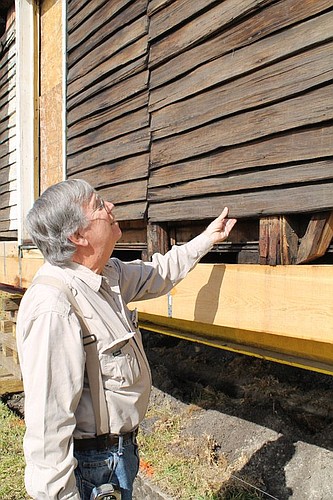
The ramshackle building looks like a hunter’s shack, one of its final uses in recent years.
But Robert White caresses the worn plank siding of the 1873 Oesterreicher homestead as if reunited with an old friend.
The boards were hand-split from logs, he said. The builder used only an adz and a few other hand tools in their making.
It’s something extremely rare. He’s worked on others from the 1880s where the wood was machine-made.
“This is probably the only building in Florida that’s like this,” said White. “If there’s another one, I’ve never heard of or seen it.”
The Beaches Area Historical Society has hired him to repair the house.
White restores the kind of old wooden buildings that most people would tear down. After 25 years in Northeast Florida, he’s built up a portfolio of salvaged 19th century barns, farmhouses and schoolhouses.
He has a couple of skills in common with the builders in whose footsteps he follows. When necessary, he hand-hews wood beams. It’s something he says very few people do anymore. And at 65, he’s “getting pretty old” to keep doing it.
Most days White is a general contractor. The restoration part of his business came from a hobby that “got out of control.”
It continues to fascinate him.
“Each of the buildings I restore tell a story and I try to uncover that story,” he said.
The Oesterreicher house was built on land that’s been absorbed by Nocatee. The historical society raised funds and moved the house in May to the Beaches Museum and History Park in Jacksonville Beach to save it from the bulldozers.
The homestead is what’s called a Cracker House, a one-room wood-framed house the early Florida settlers could build in a hurry. The simple style was defined by a wide shade porch that spanned the length of the home.
Thomas Oesterreicher in 1873 set out with a friend to build the house along 20 Mile Road in Palm Valley.
It was an area where settlers could hunt, raise cattle and harvest palm fronds to send north for Palm Sunday.
There weren’t many people living in Florida at that time, White said. Of those who did, most lived in town.
“For someone to march in the woods with an adz and axe is almost eccentric,” he said. “To find his home still standing is rare.”
Ahead of his time
Through the home’s forensics, White picks up information about the pioneer’s lifestyle.
By the time he was 18, Oesterreicher had already mastered a bit of carpentry. He also was at the cusp of some new building techniques.
For the foundation beams, he used timber frame joinery — a log cabin-style carpentry in which beams are notched and fitted onto one another. Every beam in the home is round — made from logs, not sawmill lumber.
But above the foundation, Oesterreicher used some stick-built carpentry, joining the round logs to one another with nails.
The home was built at the beginning of the Industrial Revolution. So, some of the nails were hand-forged and others machine-made.
“He had an interesting perspective,” White said, of the jumble of techniques.
The roof’s cypress shakes, which appear to be original, were also hand-split. It was more labor intensive than just putting down one-by lumber.
“He either knew it was a higher quality construction or he had a heck of a lot of energy,” White said. “The most plausible explanation is this is the way he was taught.”
To perform the restoration, White will beef up the structure for today’s building code, placing regular studs side-by-side with timbers.
Neat board paneling will be returned to the inside walls. And a porch and fireplace that didn’t make the move will be rebuilt.
The right man for the job
White is a good match for the project.
He first learned advanced carpentry as a teen from an Englishman who worked for his father. The English are famous for wood joinery and the man had spent four years studying carpentry in college.
White enjoyed the work, but wouldn’t return to it until years later, after he’d become his own contractor.
He was reading an article about timber framing and joinery in “Fine Homebuilding” magazine and he realized it was the same work he’d done as a teen. The article led him to the North American Timber Framers Guild, which White’s now been a member of for 25 years.
Guild projects took White to Monterey, Calif., and to a college in New Hampshire.
He’s worked with Japanese timber builders and taught a group of Amish how to build barns.
He read about a man who repaired old covered bridges in Ohio and went to work with him.
Another project took him to the Appalachian Mountains, where a team from the guild built a timber frame shelter that was later featured in National Geographic.
Timber framers build wood construction with few or no power tools. Instead, it’s all hand saws and chisels. It takes a high level of craftsmanship.
“Everything you do is going to be shown,” White said. “You can’t hide your carpentry behind drywall. It becomes the center point and you cannot make one mistake.”
It’s an obsession that has led White to bake oak pegs in his wife’s oven to an 8 percent moisture content.
Hammered into moist wood, the pegs swell to form an impenetrable joint.
White said his wife thinks he’s crazy. Secretly, he believes she likes it.
“I don’t golf, I don’t go to the country club, I don’t smoke, I don’t drink. This is what I do,” he said.
“I professionally remove wood where it doesn’t belong. So the structure itself becomes a work of art.”
(904) 356-2466